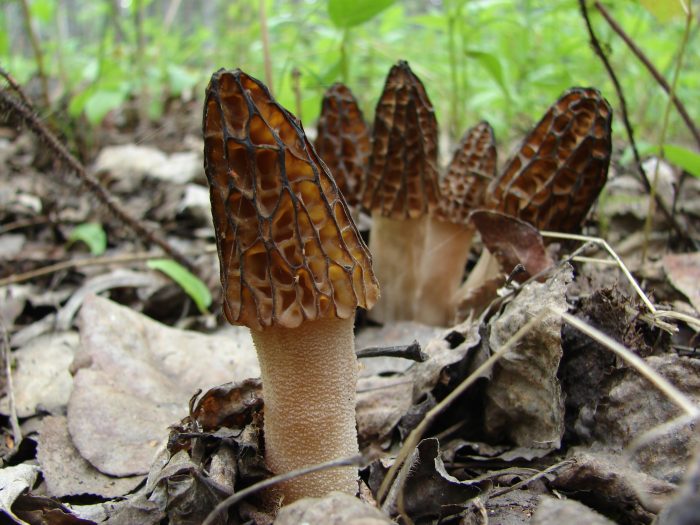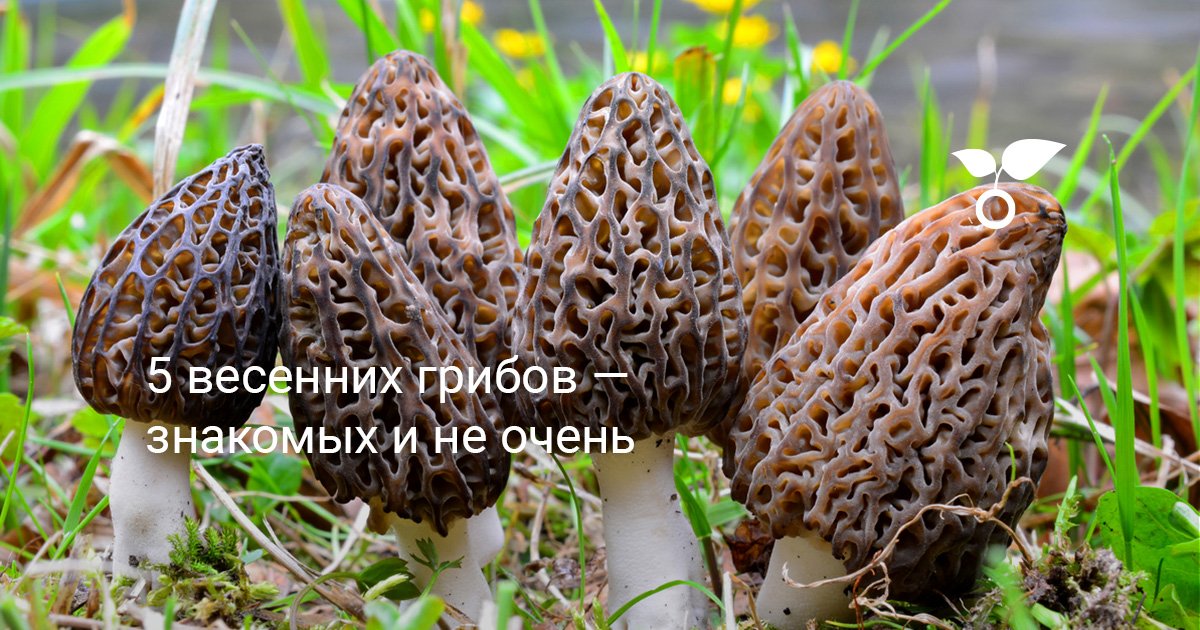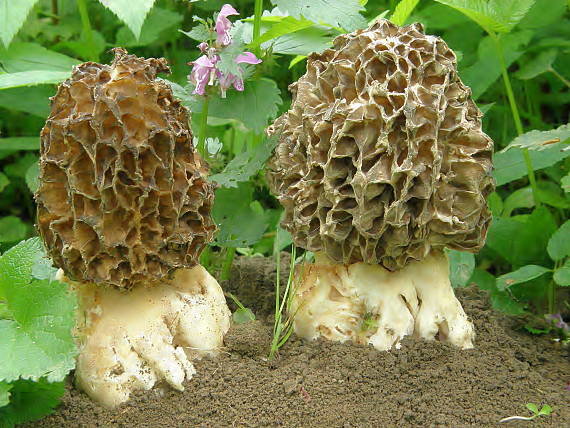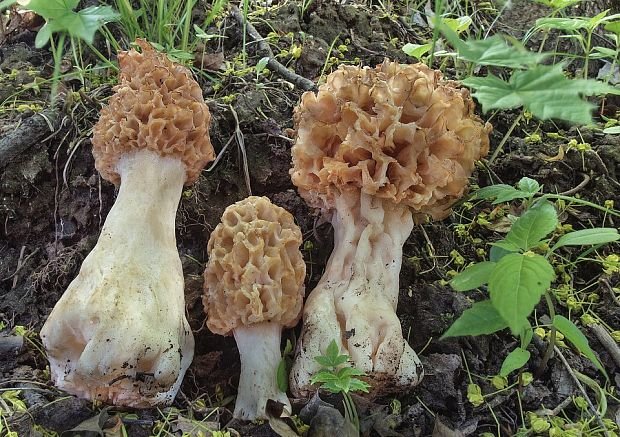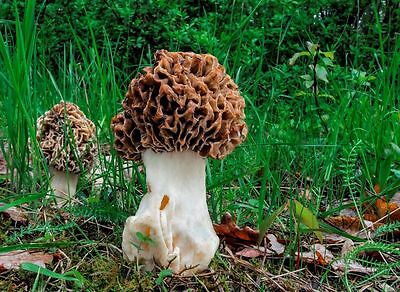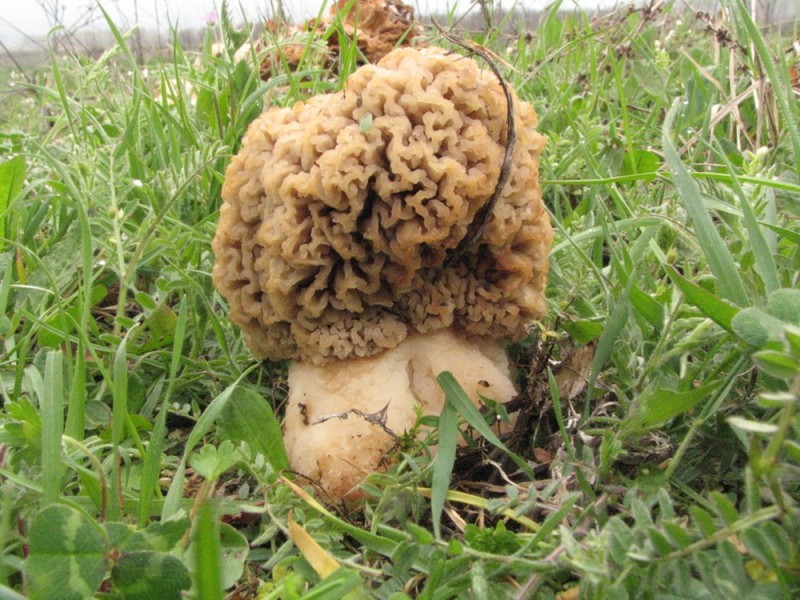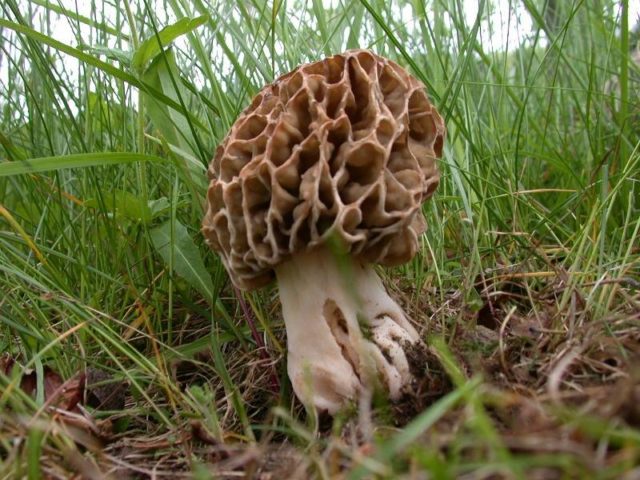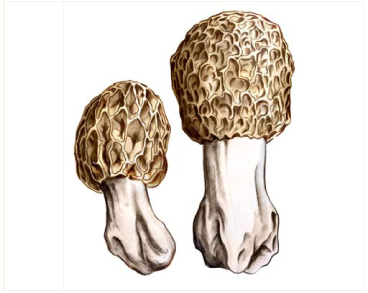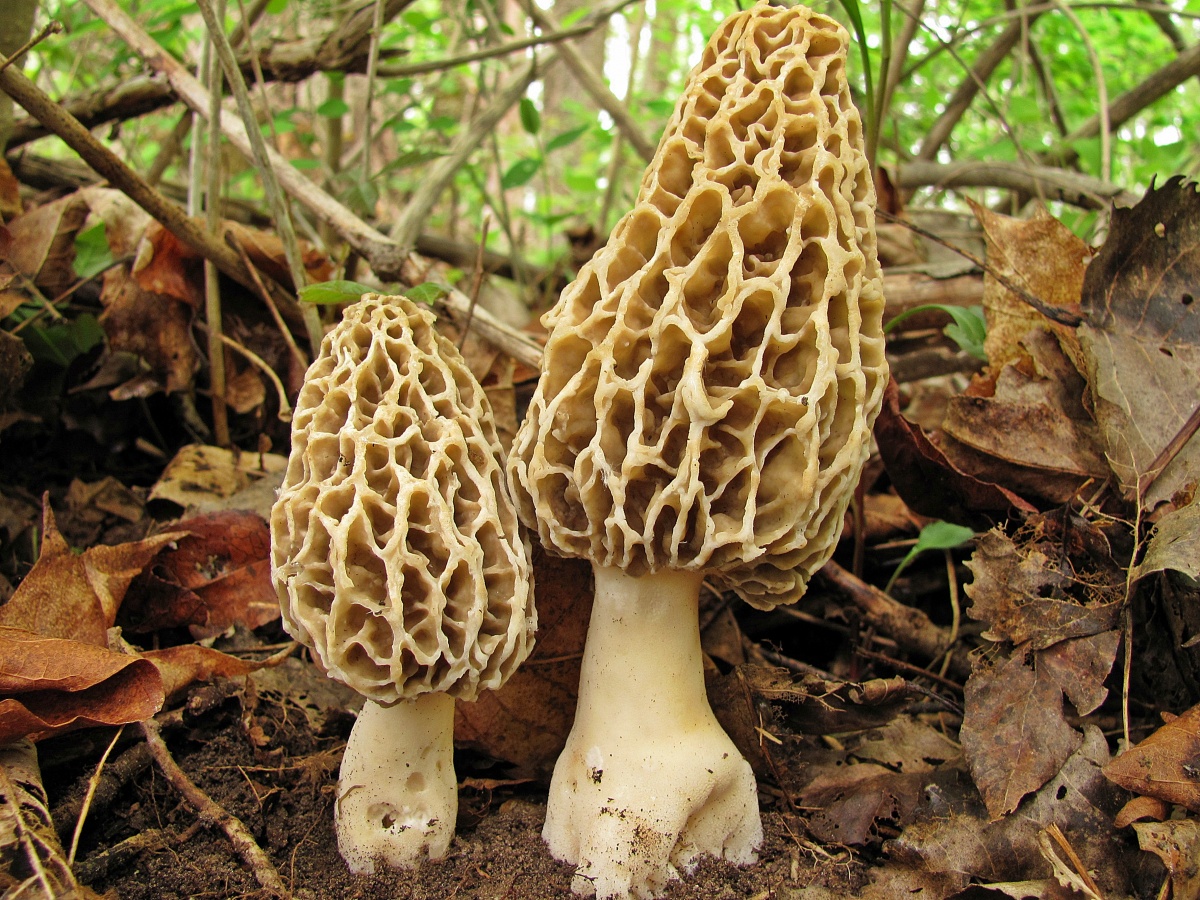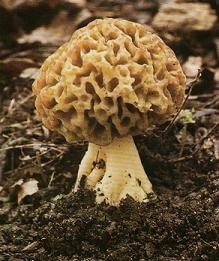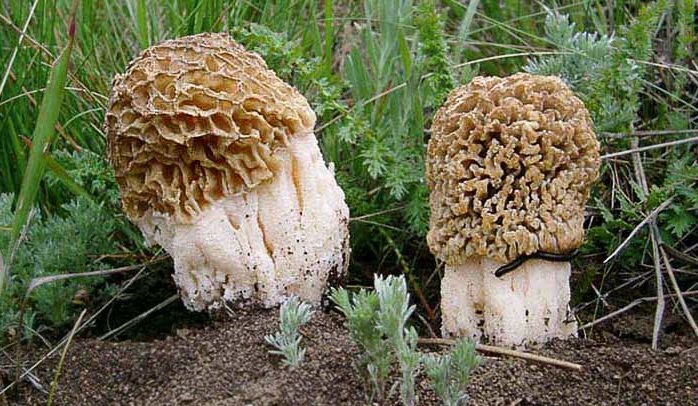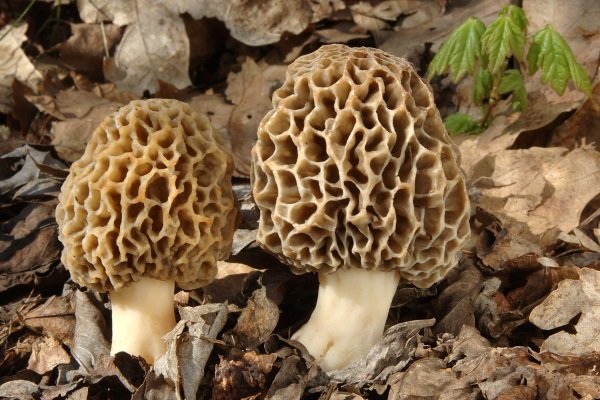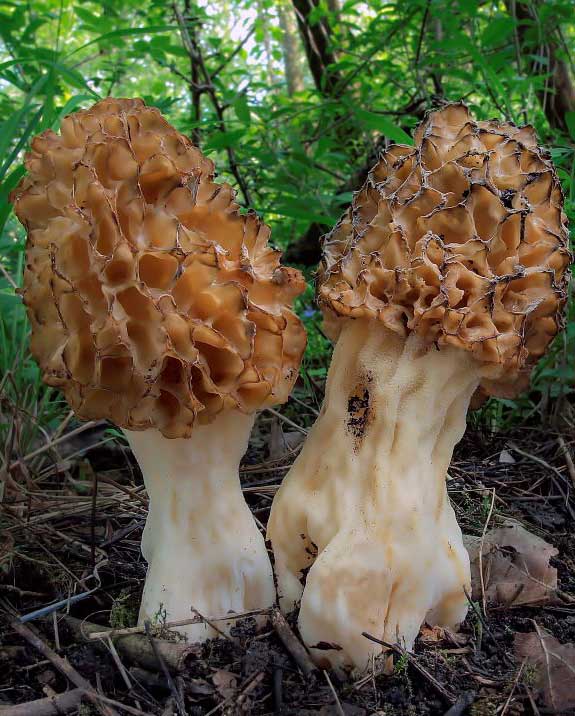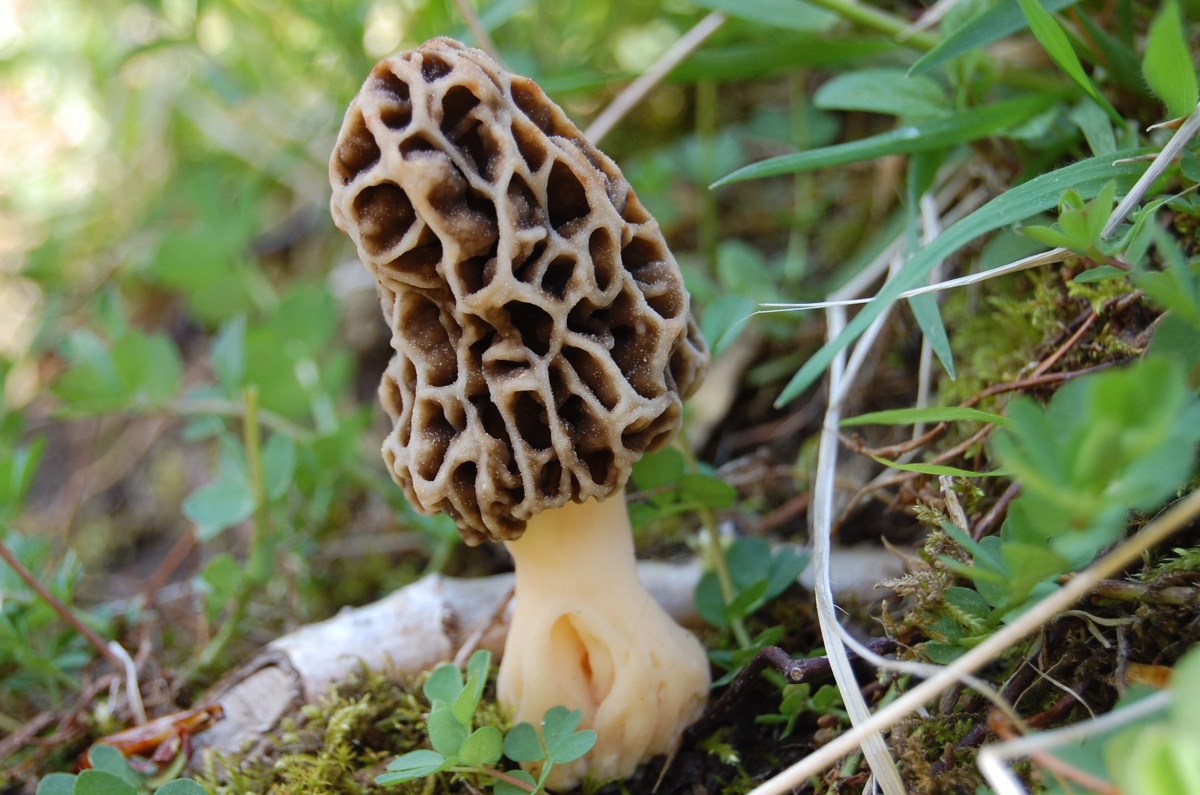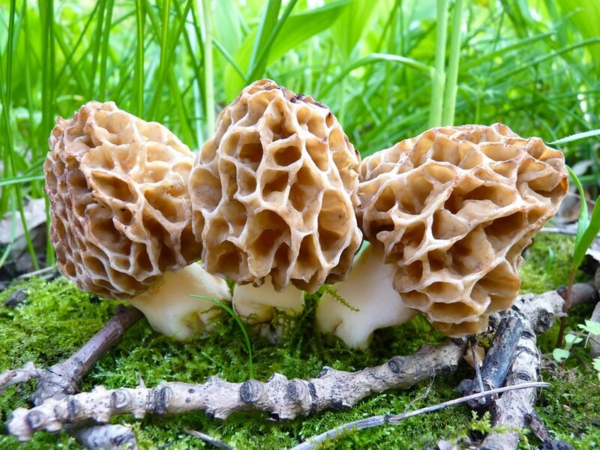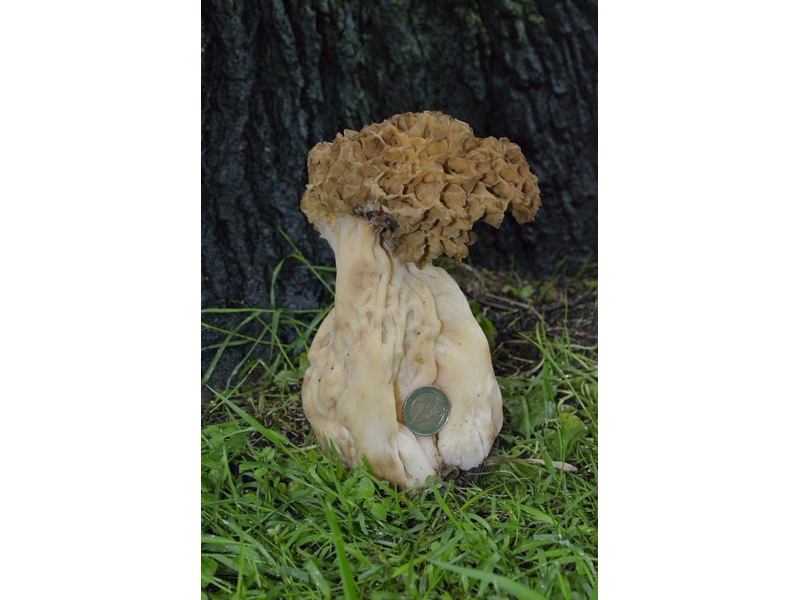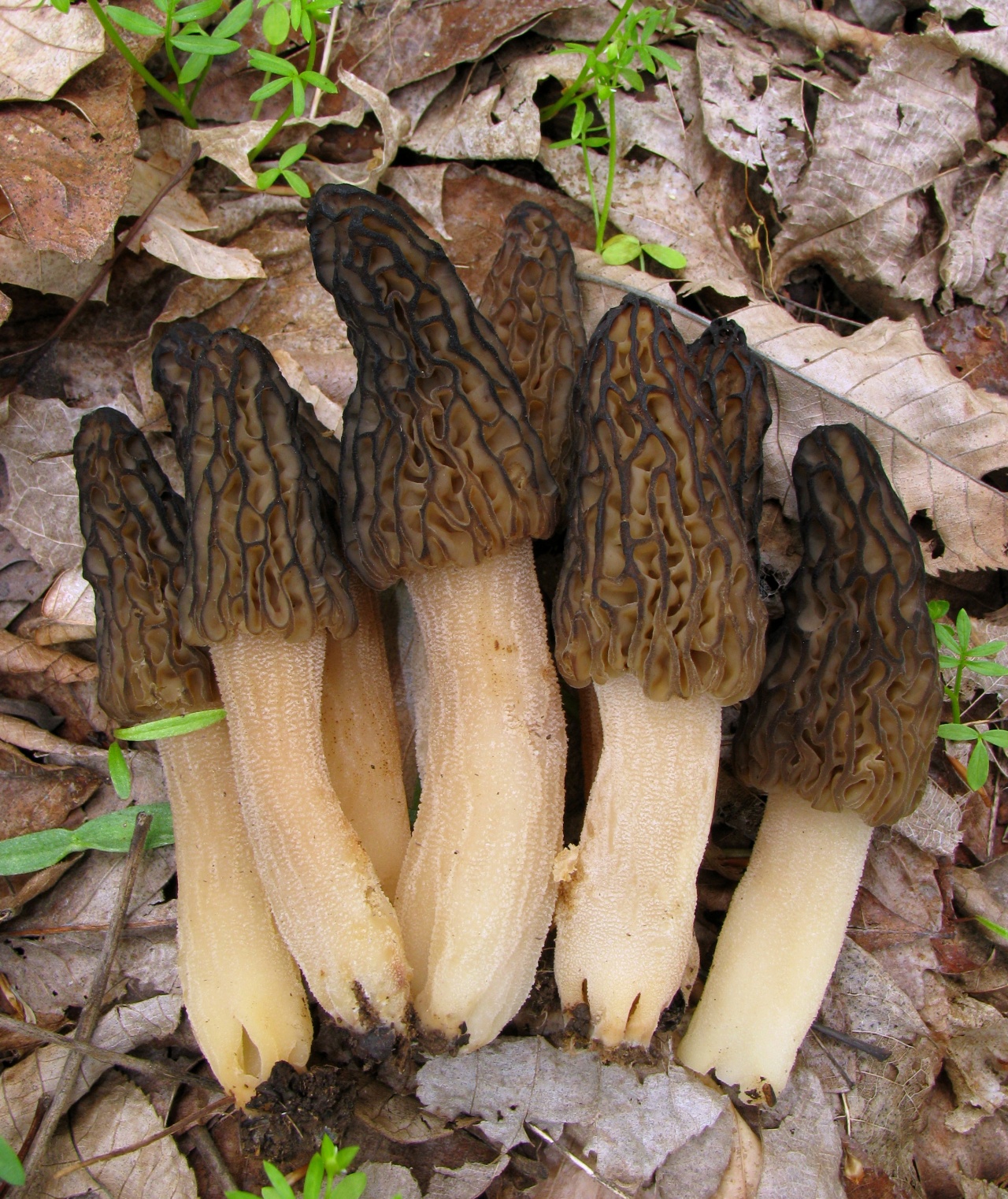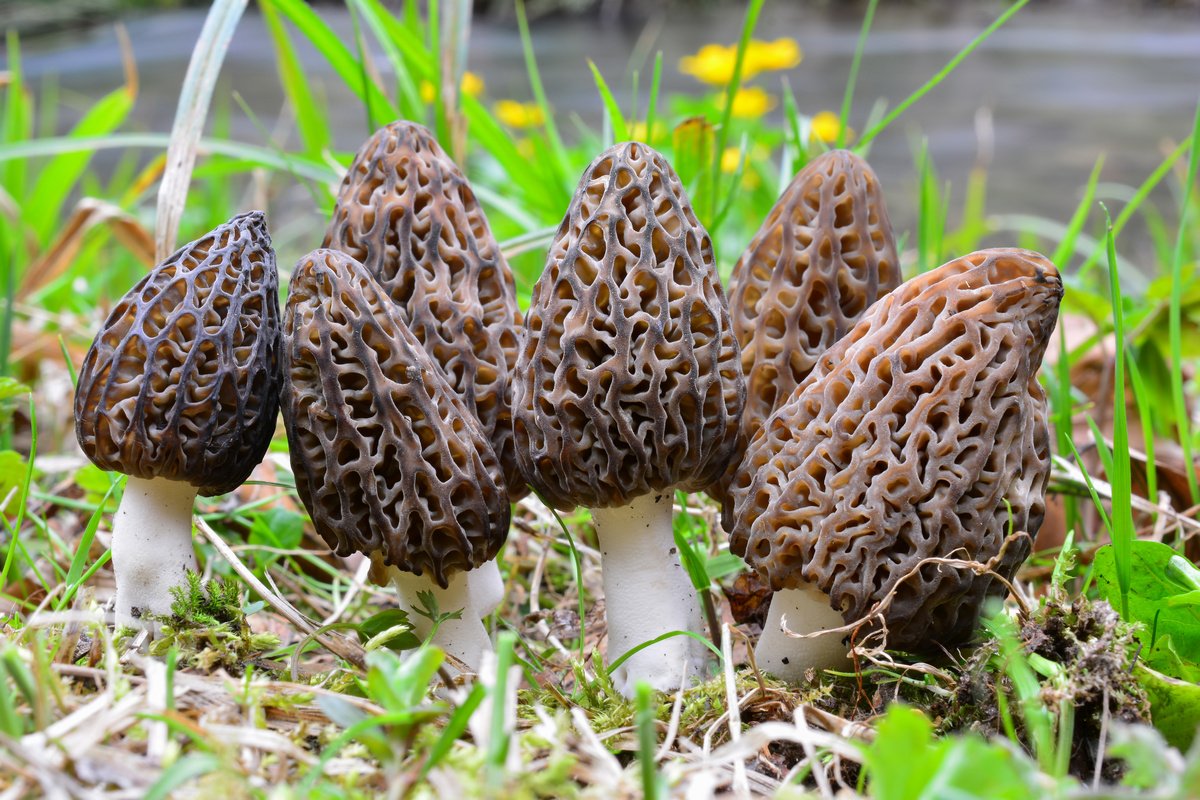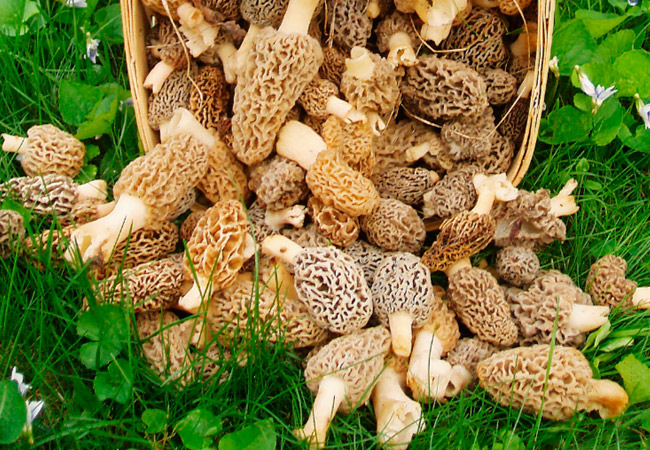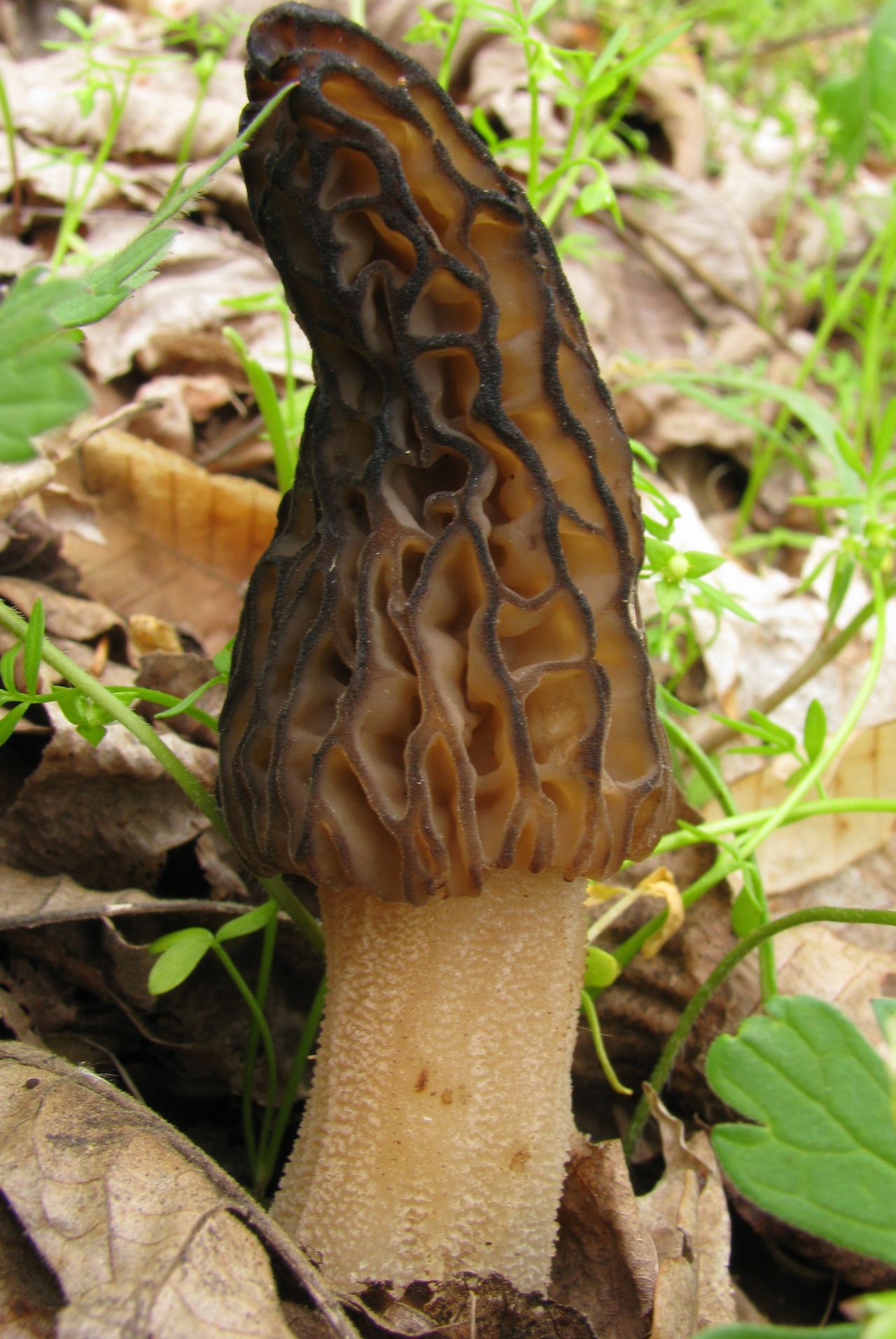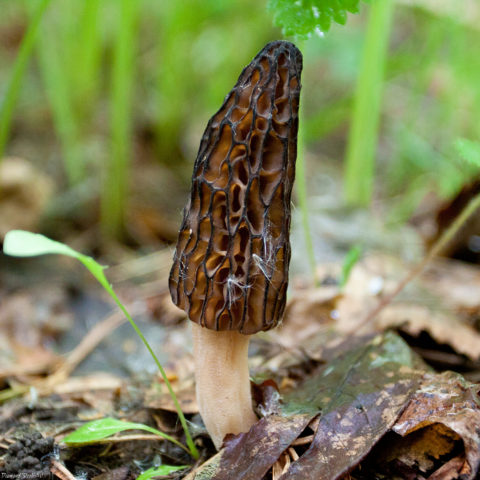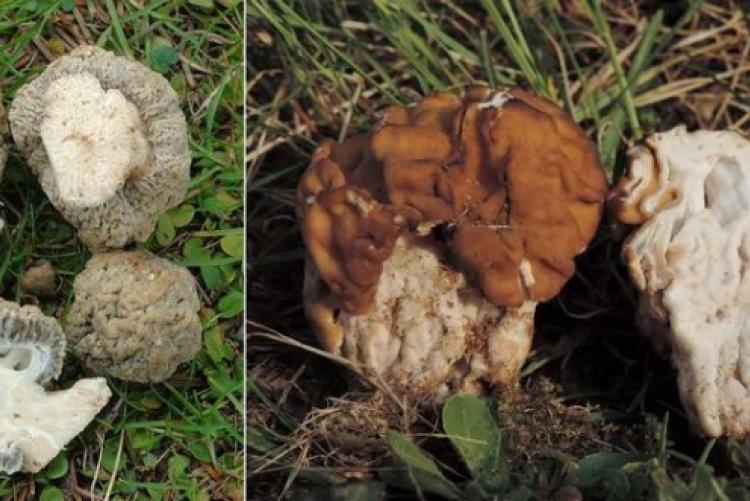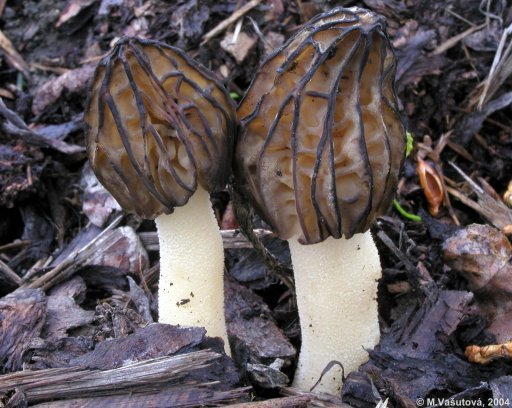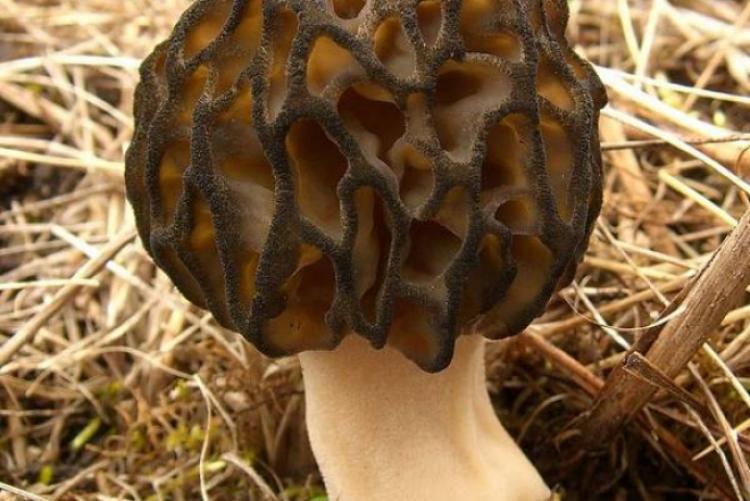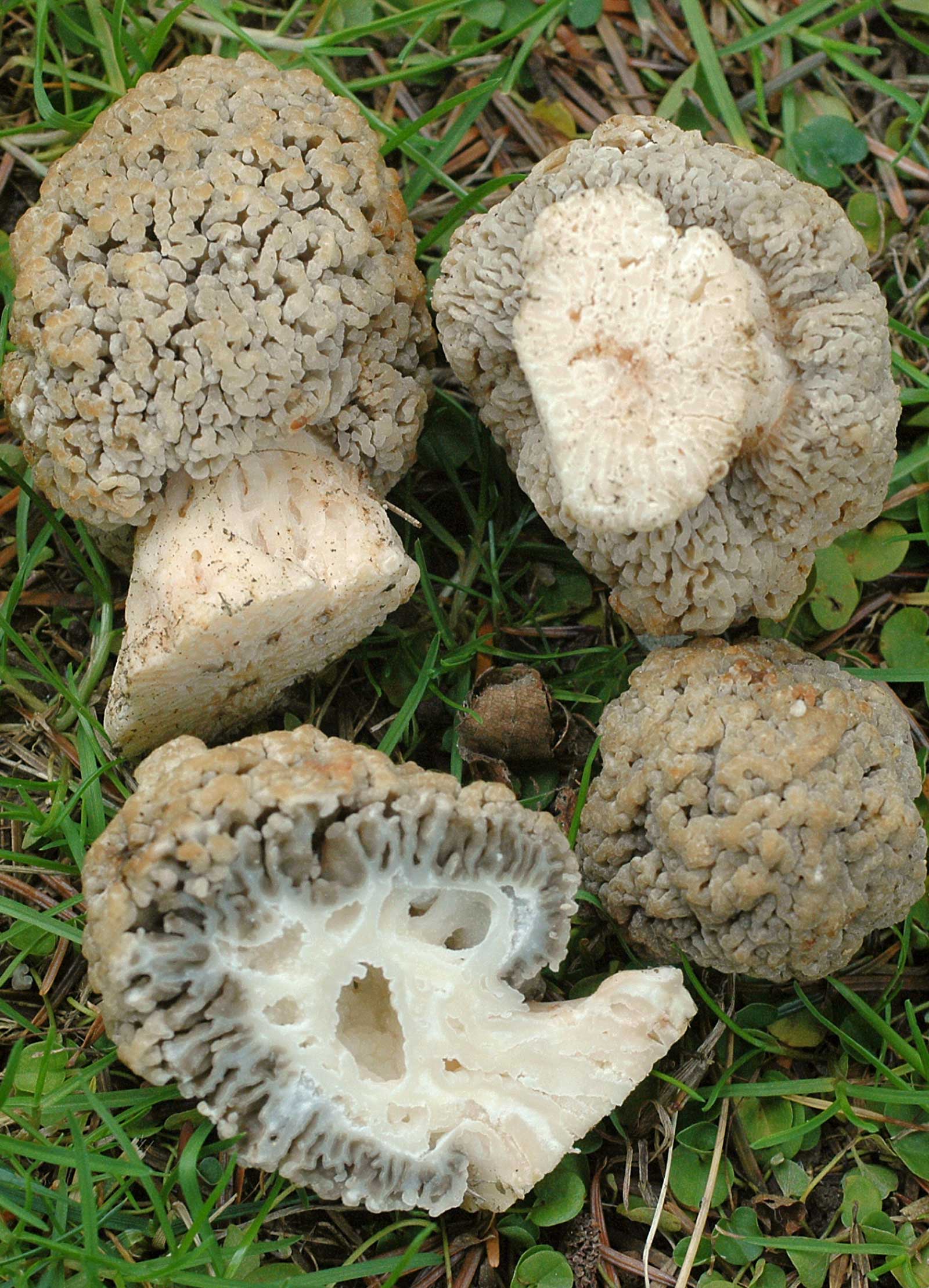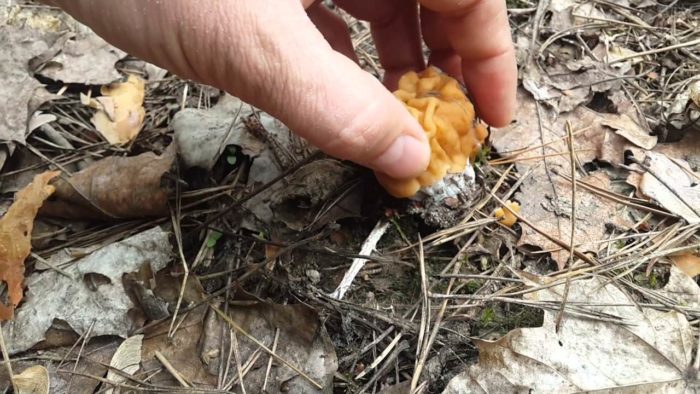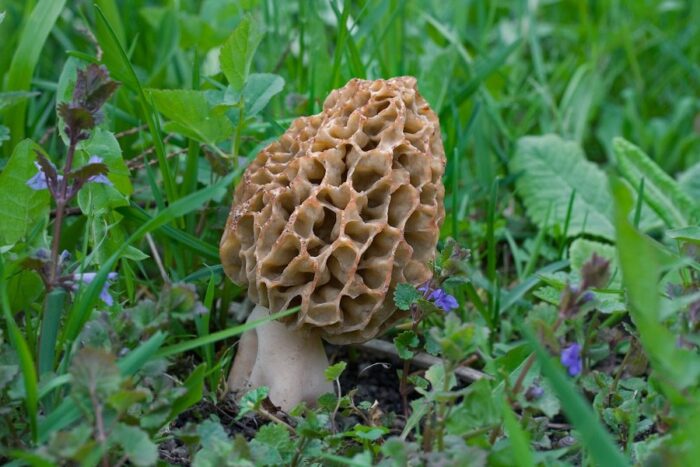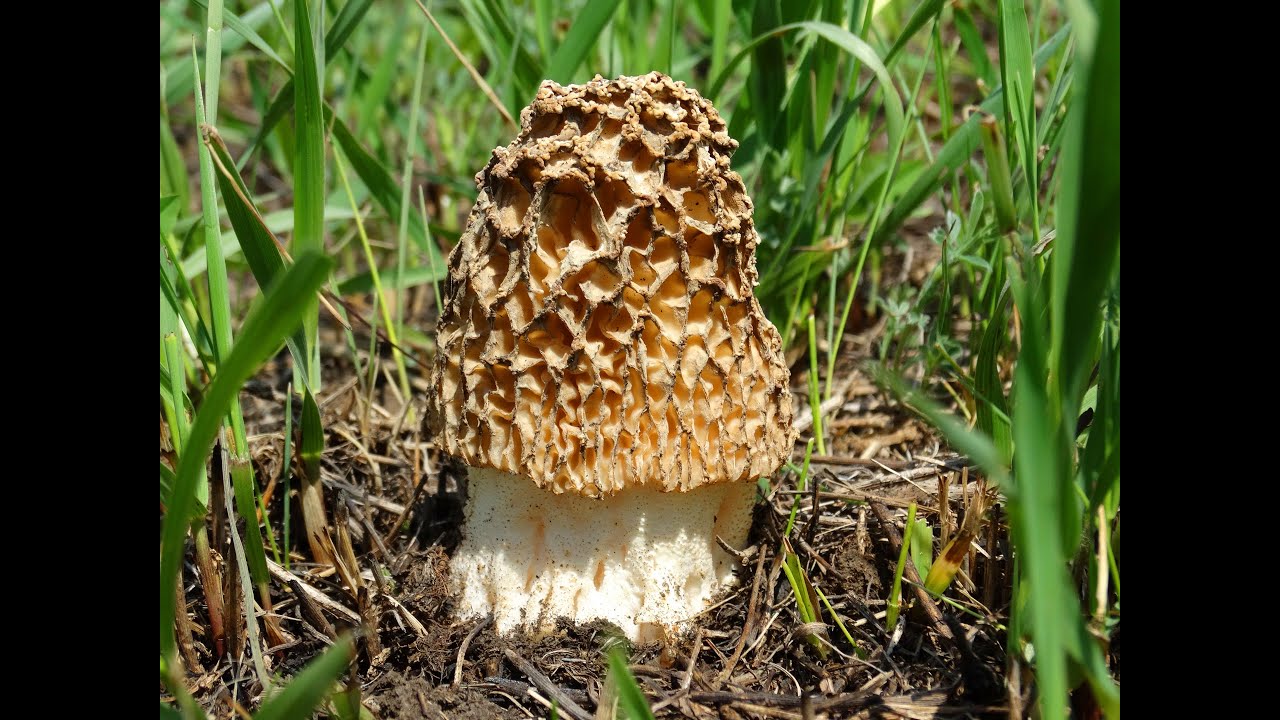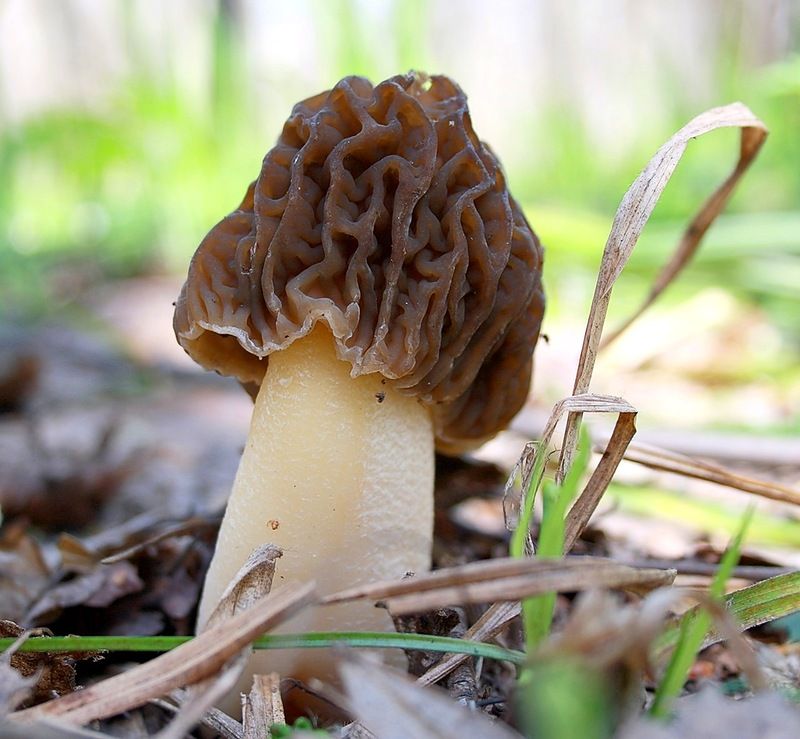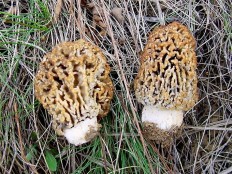Morel (Morchella esculenta)
Synonyms:
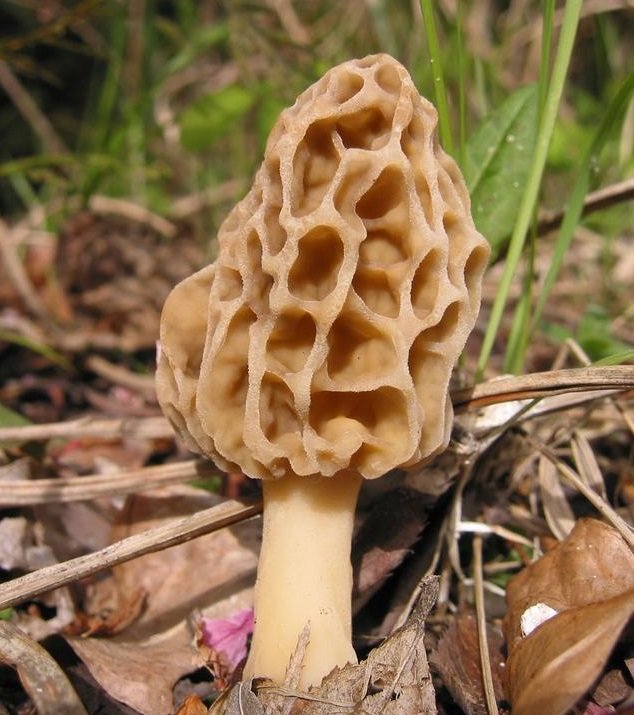
The fruit body of the edible morel is large, fleshy, hollow inside, which is why the mushroom is very light in weight, 6-15 (up to 20) cm high. Consists of a "leg" and "cap". Edible morel is considered one of the largest mushrooms in the morel family.
The cap of an edible morel, as a rule, has an ovoid or ovoid-rounded shape, less often a flattened-spherical or spherical; along the edge grows tightly to the leg. The height of the cap is 3-7 cm, the diameter is 3-6 (up to  see the color of the cap from yellow-brown to brown; becomes darker with age and drying. Since the color of the cap is close to the color of the fallen leaves, the fungus is hardly noticeable in litter. The surface of the cap is very uneven, wrinkled, consisting of deep pits-cells of various sizes, lined with hymenium. The shape of the cells is irregular, but closer to round; they are separated by narrow (1 mm thick), sinuous folds-ribs, longitudinal and transverse, colored lighter than the cells. The cells vaguely resemble a honeycomb, hence one of the English names for edible morel - honeycomb morel.
see the color of the cap from yellow-brown to brown; becomes darker with age and drying. Since the color of the cap is close to the color of the fallen leaves, the fungus is hardly noticeable in litter. The surface of the cap is very uneven, wrinkled, consisting of deep pits-cells of various sizes, lined with hymenium. The shape of the cells is irregular, but closer to round; they are separated by narrow (1 mm thick), sinuous folds-ribs, longitudinal and transverse, colored lighter than the cells. The cells vaguely resemble a honeycomb, hence one of the English names for edible morel - honeycomb morel.
Morel stem is cylindrical, slightly thickened at the base, hollow inside (makes up a single cavity with a cap), fragile, 3-7 (up to 9) cm long and 1.5-3 cm thick. Young mushrooms have whitish stem, but darkens with age becoming yellowish or creamy. A fully ripe mushroom has a brownish, mealy or slightly flaked stem, often with longitudinal grooves at the base.
The pulp of the fruiting body is light (whitish, whitish-cream or yellowish-ocher), waxy, very thin, fragile and delicate, easily crumbles. The taste of the pulp is pleasant; there is no distinct smell.
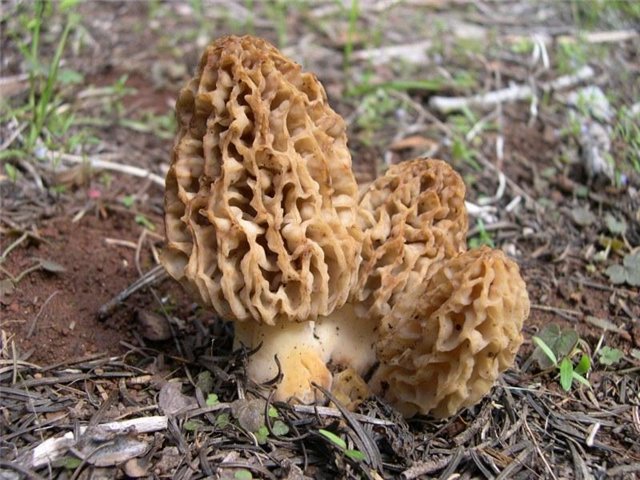
Spore powder, yellowish, light buffy. Spores are ellipsoidal, smooth, less often granular, colorless, (19-22) × (11-15) microns in size, develop in fruit bags (asci), forming a continuous layer on the outer surface of the cap. Asci are cylindrical, 330 × 20 microns in size.
Edible morel is distributed throughout the temperate zone of the Northern Hemisphere - in Eurasia up to Japan and North America, as well as in Australia and Tasmania. Occurs singly, rarely in groups; quite rare, although the most common among morel mushrooms. It grows in well-lit places on fertile, lime-rich soil - from lowlands and river floodplains to mountain slopes: in light deciduous (birch, willow, poplar, alder, oak, ash and elm), as well as in mixed and coniferous forests, in parks and apple orchards; common in grassy, sheltered places (on lawns and forest edges, under bushes, in clearings and clearings, near fallen trees, along ditches and along the banks of streams). It can grow in sandy areas, near landfills and in places of old burnt places. In southern Russia, it is found in vegetable gardens, front gardens and lawns. This fungus develops abundantly in spring, from mid-April to June, especially after warm rains. It is usually found in forests on more or less fertile soil under deciduous trees, more often in grassy, well-protected places: under bushes, along ditches, on lawns in parks and gardens.
In Western Europe, the mushroom is found from mid-April to the end of May, in especially warm years - from March. In Russia, the mushroom usually appears not earlier than the beginning of May, but can occur until mid-June, occasionally, in a long warm autumn, even in early October.
Edible morel cannot be confused with any poisonous mushroom. From related species, the morel is conical and the morel is tall, it is distinguished by the rounded shape of the cap, the shape, size and arrangement of the cells. The round morel (Morchella rotunda) is very similar to it, which, however, is often considered as a form of edible morel.
Conditionally edible mushroom of the third category.Suitable for food after boiling in boiling salted water for 10-15 minutes (the broth is drained), or after drying without boiling.
Video about the Morel mushroom edible:
Distribution and collection
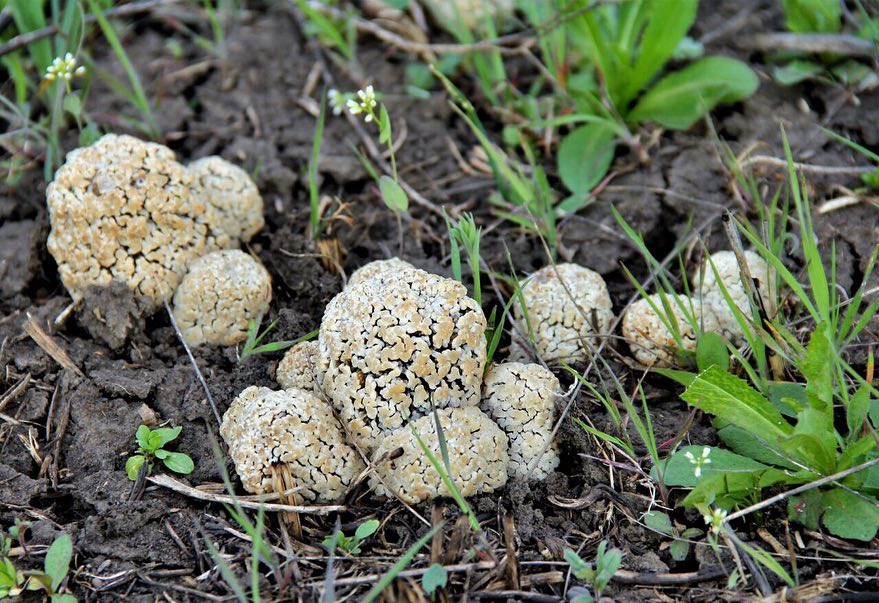
The distribution area of the steppe morel is the southern regions of the steppe zone of Europe and Central Asia. The fungus grows on clay soils, on virgin lands that are not subject to active grazing, often grows next to wormwood and Chernobyl.
When collecting steppe morels, it is important to remember that the fruiting period of an individual mycelium is very short, less than a week, on average from 3 to 5 days. If the mushroom picker finds out exactly where the steppe morel grows, he has to check these places every day so as not to miss it during the fruiting period
Often these mushrooms form numerous groups and the so-called "witch circles".
Useful properties and application
The benefits of morels are beneficial effects on:
- immunity and general condition of the body;
- vision (helps to relax the eye muscles after prolonged exertion);
- gastrointestinal system - blocks the development of genetic diseases, helps to normalize digestion;
- the circulatory system - cleans and thins the blood, which improves the condition of people with varicose veins;
- vestibular apparatus - reduces nausea from travel in transport or on a ship.
It is used not only for food, but also as part of tablets and ointments. As we mentioned above, the key to a successful morel dish is preliminary heat treatment. In the case of drying, mushrooms can be consumed no earlier than 3 months after the end of drying. The first morel broth is poured out, after which the mushrooms can be cooked.
List of the most popular dishes:
- Unleavened Russian pie with eggs and sour cream with morel filling.
- Kulebyaka with meat or fish with the addition of mushrooms.
- Homemade noodles, buckwheat porridge or tortillas with fried morels.
- Morel risotto or roast.
- Sauces for red meat (for example, "Forester").
Soup using freshly boiled morels has a faint, barely expressed taste. Drying is recommended for broth.
Where and when to look for morels
Morel mushrooms are common in the forest zone of the Northern Hemisphere with a temperate climate. As a rule, morels grow on calcareous soils, which distinguishes them from many other fungi, they need sunlight and moderate moisture. Morels usually hide in the grass, fallen leaves, or behind fallen tree trunks. Most often they grow under deciduous trees, can be found in orchards and parks, grow along streams and rivers. It is rare, but still possible, to find morels in coniferous or mixed forests. You can go in search of morels in early to mid-May, and usually the fruiting season ends in September. Provided a long and warm autumn, morels can be found until the end of October.
Reproduction of morels
Morels reproduce asexually or sexually.
- The asexual method includes reproduction by parts of the mycelium (the body of the fungus) or by conidia (motionless spores).
- Sexual reproduction is carried out with the help of ascospores (cells with half a set of chromosomes), which mature in bags (asci). Mushroom sacs are formed in fruiting bodies (apothecia), the formation of which is preceded by a sexual process called somatogamy. At the same time, vegetative hyphae of different individuals merge.
Morels are not lamellar or tubular mushrooms. Their hymenophore is smooth. The spore-bearing layer (hymen) is located along the bottom and slopes of the ribs and consists of asci with 8 ascospores. Asci are large, cylindrical, rounded at the top. Ascospores are ellipsoidal or spherical, with an uneven surface or smooth, arranged in one row, multinucleated at maturity. Morel spores can be colorless or slightly yellowish. They can be seen under an electron microscope. The release of spores is regulated by solar radiation and occurs gradually.
The life cycle of morels begins with the germination of multinucleated ascospores.The sprout gives rise to the primary haploid multinucleated mycelium, which has existed for a very short time. Ascospores are able to germinate even after prolonged dormancy or storage, after 4-5 years. The hyphae of the primary mycelium of morel form anastomoses (connection of two hyphae of one mycelium) or merge with the hyphae of another primary mycelium. As a result of the fusion, a diploid multinucleated organism emerges. In the future, he is able to enter into symbiosis with higher plants, form conidial sporulation or sclerotia (dormancy stage). The main reason for the formation of sclerotia is the lack of nutrients in the soil. In the life cycle of morels, the asexual (vegetative) stage prevails.
What is the difference between morels and lines?
Lines (Latin Gyromitra) are mushrooms that are often confused with morels. Both of them appear at approximately the same time. They are sold on the market under the general name "morels". But the lines are more poisonous, especially when raw, and in some countries they are even classified as inedible. Below are the differences between these mushrooms.
- The surface of the cap does not contain cells, it is sinuous-wavy (similar to the brain or a peeled walnut), asymmetrical and does not grow to the stem. In morels, this part of the mycelium has a more regular shape, it is covered with convex ribs of cells of different depths, and in almost all species it grows to the stem.
- The color of the cap line is yellow-brown, brown, less often brown or grayish, often with a reddish tint. In the morel, it is dirty grayish white or dark brown.
- You can also distinguish the morel from the stitching by the leg. The stitch leg is shorter (3-6 cm) and thicker (up to 5 cm in diameter). It is uneven and often swollen at the base. Sometimes it doesn't exist at all. The morel has a leg about the length of the cap. She is also more slender.
- The body of the line is not hollow inside: it is filled with septa and convolutions. On the cut, it is white with a purple tint. The cap and stem of the morel are usually empty inside, and the flesh of the mushroom is white, waxy and fragile.
Giant stitching (Gyromitra gigas)
Synonyms:
Giant stitch (lat.Gyromitra gigas) is a species of marsupial mushroom of the genus Strochka (Gyromitra), which is often confused with edible morels (Morchella spp.). In its raw form, all the lines are deadly poisonous, although there is an opinion that the giant lines are less poisonous than other species of the Strochkov genus. It is widely believed that the lines can be eaten after cooking, however, gyromitrin is not completely destroyed even after prolonged boiling, therefore, in many countries, the lines are classified as definitely poisonous mushrooms. Known in the USA as snow morel, snow false morel, calf brain and bull nose.
Giant's hat stitch:
Shapeless, wavy-folded, adherent to the stem, in youth - chocolate brown, then, as the spores mature, gradually repainted in ocher color. The width of the cap is 7-12 cm, although absolutely gigantic specimens with a cap span of up to 30 cm are often found.
Foot stitching giant:
Short, 3-6 cm high, white, hollow, wide. It is often not visible behind the hat.
Spreading:
The giant line grows from mid-April to mid or late May in birch forests or forests with an admixture of birch. Prefers sandy soil, in good years and in good places occurs in large groups.
Similar species: The common line (Gyromitra esculenta) grows in pine forests, its size is smaller and its color is darker.
Edible: Incomprehensible. In all Western literature, the lines are notoriously poisonous: the defenseless bunnies running past fall dead, unable to withstand the poisonous fumes of the line. There is no unity among our authors. But all more or less agree that the giant line is relatively less poisonous than the ordinary one (Gyromitra esculenta).The end consumer decided everything for himself long ago: in the markets, giant and ordinary lines are sold under the guise of morels.
Video about a mushroom Giant lines:
Initially, there was little that connected me with the line and the morel. And as I saw, it became uninteresting. Some kind of fake mushroom. Illusory. And he has some kind of imaginary poisonousness. Gelvelic acid, which the Enlightenment publishing house scared several generations of our mushroom pickers, no longer exists. They are looking for some other poison, find and refute what they have found. Not serious somehow.
However, every mushroom is valuable in spring. This means that each new copy is capable of evoking at least some, but emotions. So, a long and lengthy search in early May 2002 led to the finding of three copies of the giant line. The points of location, equidistant from each other, were the vertices of a triangle with a side of about two kilometers. This is the question of accuracy. The following years have passed, one might say, in vain: it was only in the spring of 2005 that one neat specimen of Gyromitra gigas was found on a forest road, very close to the anthill.
Rules for collecting conical morels
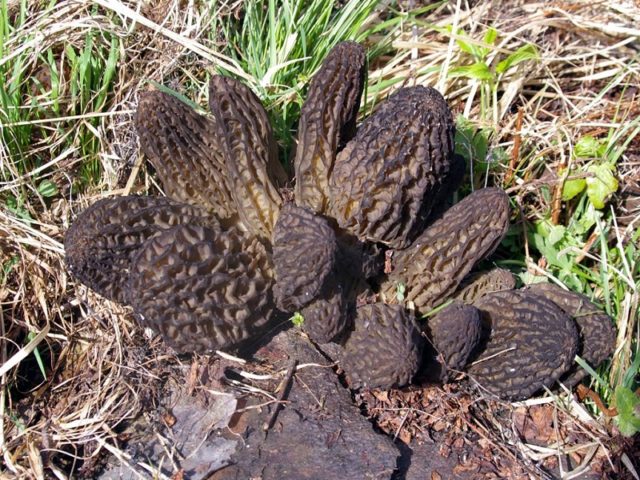
The popularity of conical morels is explained by the fact that their collection begins in the spring, when there are no mushrooms yet. Experts advise to go on a "quiet hunt" when it gets warm and earrings appear on the aspens. It is quite difficult to find them in mixed forests, since they are skillfully camouflaged, and their light caps in the dry last year's grass are hardly noticeable. If one mushroom is found, then several more will definitely be found nearby, but for this you need to change the point of view.
It is much easier to find conical morels in clearings and burned areas. Here they have a dark color and are clearly visible. Mushrooms like to hide in heaps of brushwood and settle there with whole families. Often they are found on the sides of roads, earthen dumps.
Important! Only young strong specimens of morels are collected, carefully placing them in a rigid basket so that they do not break
The benefits and harms of morels
Morels are a traditional food in many countries around the world. Morels and stitches are served as gourmet additions to main dishes in European restaurants. The composition of mushrooms includes a rich complex of organic and mineral substances:
- up to 25% proteins,
- essential amino acids (threonine, lysine, valine, methionine, isoleucine, leucine),
- all B vitamins,
- minerals (Zn, K, Mg, Cu, Ca, Na, Fe, etc.).
In traditional oriental medicine of Asian countries (India, China, etc.) morels are used in the form of decoctions, teas and infusions. The literature indicates that due to the use of fruit bodies and water extracts of the species M. Deliciosa (gourmet morel), M. Conica (conical morel), M. Esculenta (edible morel), the function of the gastrointestinal tract improves, immunity increases, and inflammatory processes decrease. In Russia, conical morel infusions were used to treat cataracts, myopia and age-related changes in vision. Modern scientific research has confirmed the medicinal properties of M. conica and M. esculenta. The substances that make up them stimulate the immune system and improve metabolic processes.
In addition to the beneficial properties, morels have contraindications. They are not recommended for use by children under 12 years of age, pregnant women and nursing mothers. In addition, improperly cooked, raw or old morels can cause poisoning, destruction of red blood cells and jaundice.
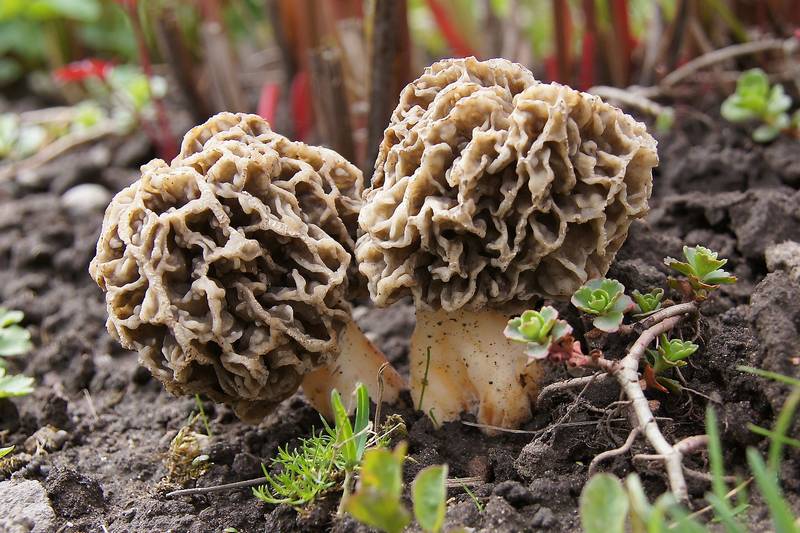
Photo by: TOMMES-WIKI, CC BY-SA 3.0
Edible varieties
The line mushroom is practically not an edible species. All varieties allowed for consumption belong to the third type of edibility or conditionally edible fruit. For the preparation of the "Giant" and "Beam" line, you should carry out a long heat treatment, including:
- the washing up;
- soaking in saline solution for 1-2 hours;
- double boiling with water draining (each process should take at least 40 minutes);
- repeated rinsing;
- drying before further cooking.
# 1 - Giant line
Large mushrooms in comparison with other varieties. Their cap can be up to 60 cm wide. In spring, they stand out well against the background of greenery, thanks to their brown-red color. Like any other representatives of the species, they have a flat stem and cells on the cap.

No. 2 - Tufted stitching
The mushroom can reach a height of 20 cm. The fruiting body is not quite ordinary. The hat is horn-shaped, has two or three pointed corners directed in different directions. The leg is short, hiding behind the upper part. Many mushroom pickers compare the exotic variety with the horns of a young fawn.

The collection of line mushrooms of these varieties on the territory of Russia is allowed due to the minimal toxicity, in comparison with other countries where the germination of forest fruits can be observed. Some chefs prefer to completely eliminate harm by choosing long-term drying for cooking. The latter, however, act in the old fashioned way, boiling the fruits several times in new water. The choice of the method of heat treatment applies only to two types. The rest of the varieties are dried, or completely excluded from the diet, bypassing in the forest belt.
Beanie Morel Verpa bohemica

Beanie Morel Verpa bohemica
A relative of true morels, although it belongs to a different genus. It is inferior in taste to real morels, but also appreciated among mushroom pickers. It is also called "Cap", "Czech Verpa" and "Tender Morel".
Appearance
The cap has the shape of a cap, with a height of 2 to 5, a diameter of 2 to 4 cm. It is not attached to the bottom of the leg and is very easily removed from it. The hat is covered with vertical folded wrinkles. The color changes from brownish-chocolate in young mushrooms to yellowish-ocher in mature ones.
The stem is smooth and slightly curved, 6 to 10 in length and 1.5 to 2.5 cm in diameter. On the sides it is slightly flattened and covered with small scales. In young mushrooms, the leg is whole, in mature mushrooms, with a cavity inside.
The pulp is light, brittle and thin, it smells very nice. The taste is poorly expressed.
When and where to collect the Morechkovaya Hat
This mushroom bears fruit only from the very end of April and the first half of May, so hunting for it is especially exciting - you need to catch it in time. He is very fond of dampness and does not tolerate the absence of moisture, therefore it grows on flooded soil, in light deciduous and mixed forests, next to aspens, lindens and birches. Look for it in the lowlands near ditches and water pits. A lucky mushroom picker can expect a gift - Caps sometimes grow in a huge herd of up to 80 pieces.
Morels are very tasty mushrooms, when they are fried, such an aroma spreads around the house that people saliva like Pavlov's dog
But there is one IMPORTANT RULE in their preparation.

There is nothing wrong with that, however. The acid is completely destroyed in morels after boiling for 15-20 minutes. In this case, the broth must be poured out - the acid has gone into it. Before boiling, it doesn't hurt to soak the mushrooms for half an hour in cold water - this will wash them off and help eliminate harmful substances in the mushrooms.
Boiled - disinfected morels can be cooked in any way you want. They are good both stewed and fried, and in mushroom soup.
Edibility, useful properties and restrictions on use
There is no single answer to the question of the edibility of morels. Some mycologists consider the use of these mushrooms dangerous, others talk about the possibility of using them raw.

Edible morel or not?
All varieties of this mushroom genus are allowed to be eaten. But they cannot be called edible in the full measure of this definition. Most mycological reference books classify representatives of the Morechok genus as conditionally edible. This distribution is caused by the need for heat treatment before using the mushrooms for gastronomic purposes.

Before cooking, morels must be boiled.Modern research refutes the assumption that mushrooms must be blanched for at least half an hour. It is enough just to scald them with boiling water. But, as you know, with forest mushrooms, jokes are bad.
In this case, excessive precaution does not hurt.

Description of steppe morel
Steppe morel is the largest among Russian morels. His hat is spherical or egg-shaped, its diameter is 2-10 centimeters, and sometimes it reaches 15 centimeters, while the height corresponds to the diameter. The edge of the cap is adherent, it is hollow inside, it can be divided into sections.

The leg to which the cap is attached is very dense and short - its length does not exceed 1-2 centimeters, sometimes the leg may be absent altogether. The color of the leg is white with a cream shade. There are rare voids inside the leg. The pulp is quite elastic, whitish in color. Spore powder is white or light gray.
Growing places of steppe morels
Steppe morels grow in the European part of our country and in Central Asia. These mushrooms settle in the wormwood steppes. They bear fruit from April to June. When collecting, it is recommended to cut the morels with a knife so that a whole mycelium remains. To find these mushrooms, you have to visit the harvesting sites every day at the beginning of March, otherwise you can skip the beginning of the harvest, and after 3-4 days the season will end altogether.
Fruit bodies in steppe morels develop very quickly, and their lifespan is only 5-7 days, in comparison with ordinary "long-playing" morels, this is extremely small.

In years with humid winters, steppe morels can form "witch circles", consisting of about 20 fruiting bodies, and the diameters of such circles reach 7-8 meters. In dry springs, mushrooms may not appear for several years in a row.
Edibility of steppe morels
Steppe morels are delicious edible mushrooms. They are mushroom delicacies, from which you can prepare independent dishes, as well as sauces and side dishes.
Drying steppe morels is not difficult at all, since they are the densest among other morels. These fungi have practically no internal cavities. The pulp of the steppe morels is similar in consistency to the pulp of the porcini mushroom. Before drying, these mushrooms must be blown out, since there are too many folds and convolutions in their caps, into which sand and dirt are clogged. The sand from the mushrooms simply cannot be shaken out, they are first dried a little in the sun, then they are blown out, and only then they are dried.
Also, these mushrooms can be dried in a special electric dryer, but in the sun they will have a more pronounced mushroom aroma.

If the dried morel is soaked for 8-10 hours, it will completely restore its structure, volume and shape. Steppe morels do not need preliminary boiling. They go well with meat, poultry and fish. Steppe morel powder makes an excellent seasoning for broths, sauces, vegetable and meat dishes. In addition, very tasty mushroom kebabs are obtained from steppe morels.
Other morels
Morel conical - conditionally edible mushroom. His hat is elongated and conical. Its diameter does not exceed 3 centimeters, and its height reaches 10 centimeters. The color of the cap is reddish-brown with a gray or green tint, sometimes the cap may be black. Its surface is cellular, outwardly it looks like a honeycomb. The leg is straight, hollow, white or yellowish.
Conical morels grow on well-heated soils, in clearings and forest fires. Often these mushrooms settle in aspen forests. They bear fruit from April to May. The flesh of conical morels is tasty and soft, but it requires preliminary boiling for 15 minutes.

Morel cap, or cap, or tender morel is a conditionally edible mushroom. A small cap has the shape of a cap, its diameter is 2-4 centimeters, and its height is 2-5 centimeters. The color of the cap at a young age is chocolate brown, and in mature it becomes ocher yellow.The leg is smooth, most often curved, its length is 6-10 centimeters, and its thickness reaches 2.5 centimeters. The leg is often flattened on the sides. With age, an enlarged cavity forms in the leg. The cap and the leg are not firmly connected. The color of the leg is cream or white.
The morel cap is the smallest species in the morel family. These mushrooms bear fruit in mid-May. They often grow among young aspens and lindens. They give preference to poor soils. Under favorable conditions, morel caps are found in large numbers.
Morel hats are eaten only after preliminary boiling, then they can be fried, boiled and cooked in any way. It takes at least a month to dry a morel cap.

Dangerous false doubles
It is difficult to confuse the real morel with other species, since it differs very characteristically from most poisonous species; in the Morechkov family, all mushrooms are considered conditionally edible. Nevertheless, an inexperienced mushroom picker should look at the difference in the photo in order to distinguish morel from the most dangerous double - the line of an ordinary one.
The differences between the morel and its dangerous brother can be seen in the table:
| Type of mushroom | Hat | Leg |
Morel edible |
Conical, folded-cellular, hollow inside | White, long, hollow inside, brittle |
Ordinary line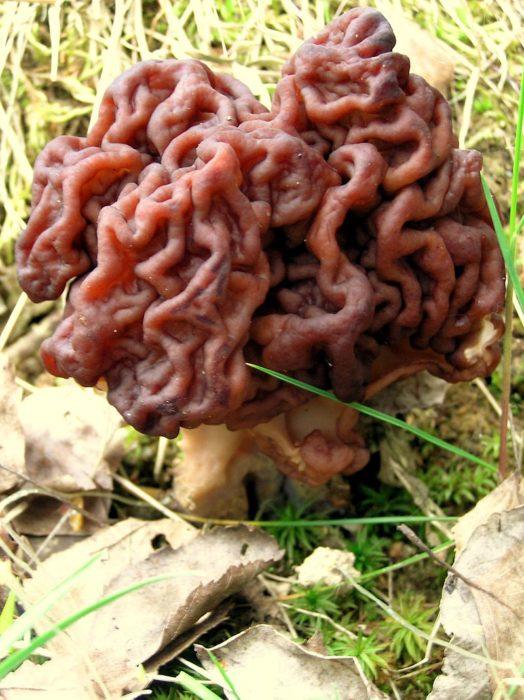 |
Flattened, similar in shape and folds to a walnut, has no cavity | Short, thick, empty, with a pink tint |
Where do morels grow and when can they be harvested?
Morel mushrooms are common in the temperate zone of the Northern Hemisphere: North America and Eurasia. They are also found in the mountainous regions of Turkey, India, Guatemala, Mexico. Some species are known in areas with Mediterranean and subtropical climates. In the Southern Hemisphere, few members of the genus grow in the forests of Australia, Tasmania, Chile and Argentina. There are 5 species of morels growing in Russia. Basically, they occupy mixed and deciduous forests, but some species are also found in the taiga.
The first spring mushrooms appear in April-May, and morels grow a little later than the lines. Depending on the weather, the time of their appearance can be shifted by 2-3 weeks. Morels season begins at a time when the forest is cleared of snow and fern fringes unfold in it. Harvesting time for morels is short and is only two weeks. Less often, mushrooms appear in the fall, but during this period, among the abundance of other mushrooms, they have little practical value.
Morels occupy the slopes of ravines, forest glades and forest edges, thickets of willow, aspen, forest roadsides, clearings. Often and in large numbers, they are found on burnt-out areas, 2-3 years after the fire, they grow on charred stumps and fireplaces, where morels and lines can be collected most successfully. All snowdrop mushrooms prefer bright places and wet weather: when the soil dries up and a lot of grass appears on it, representatives of the morel genus can no longer be found.

Photo by: Epegeiro, CC BY-SA 3.0 pl
Morel mushroom: types and description. Stitching mushrooms and morels: photo and description
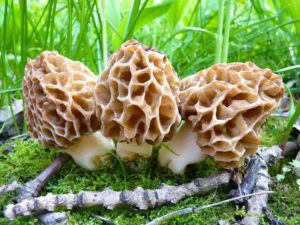
Morel - Morchella
An edible mushroom belonging to the Morechkov family.
It is a porous mushroom with a brownish cap that looks like a loofah. The hat rests on a light leg.
Morels are not eaten raw, as they require heat treatment. Some species are considered edible, some are conditionally edible.
They love to grow in old fires, which are already 2-3 years old, but sometimes they grow all year round also in old ones.
Morel common
Where are common morels (Morchella esculenta) harvested: in grassy places of deciduous and mixed forests, more often next to ash, poplar, elm, in bushes, on the edges and in plantings, they grow in groups or singly.
Season: March - May.
The hat has a diameter of 4-8 cm and a height of up to 10 cm. A distinctive feature of the species is an ovoid or conical-bell-shaped cap of light brown or brown color with a cellular surface. The cap grows together with the leg from below.The surface of the cap is cellular-ribbed with elongated rhomboidal cells, similar to a honeycomb, separated from each other by thin partitions.
The leg is 4-12 cm high, 15-30 mm thick, thick and strong, grooved, yellowish or light brown, cylindrical, hollow inside. The base of the pedicle is strongly thickened.
Flesh: whitish, light brown, with a faint pleasant odor.
Variability. The color of the cap varies from light brown and yellow-brown to dark brown.
Similar species. Morel mushrooms by the nature of the surface look like conical morels (Morchella conica). A distinctive feature of the common morel is a relatively large cellular cap, which is attached to the stem along the entire contact plane.
Cooking methods: mushrooms are fried, boiled, canned, dried.
Edible, 3rd category.
Medicinal properties: Similar to conical morels.
These photos show what the common morels look like:
How to use it correctly?
Morels must be properly processed before cooking:
- Go through the collected mushrooms, cut off the tips of the legs.
- Place the mushrooms in a large bowl and cover with clean water.
- Soak them in water for two hours.
- During this time, mix 3-4 times.
- After that, rinse the morels three times, changing the water all the time.
- Transfer to a saucepan, add water, salt, bring to a boil, cook for 10 minutes.
- Drain the water.
- Fill with new water and repeat the procedure.
- Place the cooked morels in a colander.
- Allow excess water to drain.
After that, mushrooms can be used for the first courses, fried, stewed, used in fillings, and cooked mushroom caviar.
If further cooking involves frying in oil, cover the pan with a lid to avoid splashing hot liquid.


